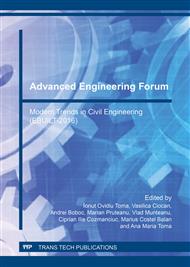p.468
p.474
p.482
p.489
p.497
p.506
p.514
p.520
p.529
The Surface Temperature Factor - An Assessment Criterion of Superficial Condensation Risk
Abstract:
The emergence of condense phenomenon, generally associated with the mould, on the inner surface of the closing elements affects not only the finishing works quality, but also the comfort conditions and, not least, the occupants’ health. The phenomenon is caused by the simultaneous action of several categories of factors. If factors related to the design and structure of closing elements can be controlled by proper design and execution respecting the quality requirements, those related to users’ behaviour and to indoor and outdoor climate conditions, have a variable and random character. Hence there is the possibility that all or most of parameters, that reflect the action of these factors simultaneously, reach values that can cause mould and condensation on the surface. In these circumstances we can speak of a risk level defined as the possibility of producing an undesirable event. The risk assessment involves the precise definition of it and finding a way to calculate how often such an event may occur under particular conditions. One of the criteria to be taken into account to estimate the risk of superficial condensation is the temperature factor. The effective value of this criterion is influenced by several categories of factors that refer to the indoor climate conditions influenced by users’ behaviour, constructive and architectural features and outdoor climate. The objective of this paper is to integrate a phenomenological approach of producing the surface condensation and mould in a complex analysis, through this global criterion, using the concept of "risk”.
Info:
Periodical:
Pages:
497-505
Citation:
Online since:
March 2017
Price:
Сopyright:
© 2017 Trans Tech Publications Ltd. All Rights Reserved
Share:
Citation:


